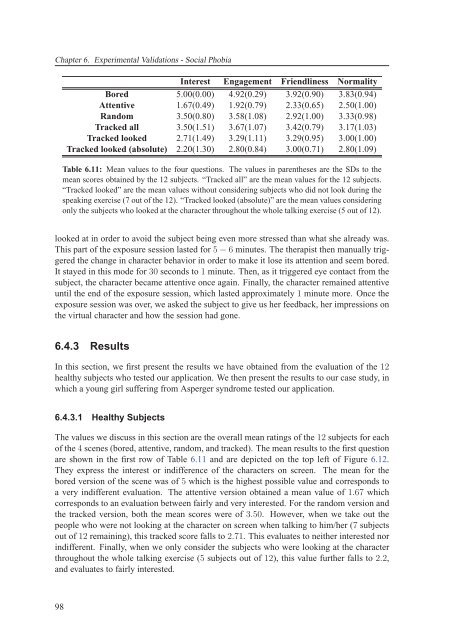Texte intégral / Full text (pdf, 20 MiB) - Infoscience - EPFL
Texte intégral / Full text (pdf, 20 MiB) - Infoscience - EPFL
Texte intégral / Full text (pdf, 20 MiB) - Infoscience - EPFL
Create successful ePaper yourself
Turn your PDF publications into a flip-book with our unique Google optimized e-Paper software.
Chapter 6. Experimental Validations - Social Phobia<br />
Interest Engagement Friendliness Normality<br />
Bored 5.00(0.00) 4.92(0.29) 3.92(0.90) 3.83(0.94)<br />
Attentive 1.67(0.49) 1.92(0.79) 2.33(0.65) 2.50(1.00)<br />
Random 3.50(0.80) 3.58(1.08) 2.92(1.00) 3.33(0.98)<br />
Tracked all 3.50(1.51) 3.67(1.07) 3.42(0.79) 3.17(1.03)<br />
Tracked looked 2.71(1.49) 3.29(1.11) 3.29(0.95) 3.00(1.00)<br />
Tracked looked (absolute) 2.<strong>20</strong>(1.30) 2.80(0.84) 3.00(0.71) 2.80(1.09)<br />
Table 6.11: Mean values to the four questions. The values in parentheses are the SDs to the<br />
mean scores obtained by the 12 subjects. “Tracked all” are the mean values for the 12 subjects.<br />
“Tracked looked” are the mean values without considering subjects who did not look during the<br />
speaking exercise (7 out of the 12). “Tracked looked (absolute)” are the mean values considering<br />
only the subjects who looked at the character throughout the whole talking exercise (5 out of 12).<br />
looked at in order to avoid the subject being even more stressed than what she already was.<br />
This part of the exposure session lasted for 5 − 6 minutes. The therapist then manually triggered<br />
the change in character behavior in order to make it lose its attention and seem bored.<br />
It stayed in this mode for 30 seconds to 1 minute. Then, as it triggered eye contact from the<br />
subject, the character became attentive once again. Finally, the character remained attentive<br />
until the end of the exposure session, which lasted approximately 1 minute more. Once the<br />
exposure session was over, we asked the subject to give us her feedback, her impressions on<br />
the virtual character and how the session had gone.<br />
6.4.3 Results<br />
In this section, we first present the results we have obtained from the evaluation of the 12<br />
healthy subjects who tested our application. We then present the results to our case study, in<br />
which a young girl suffering from Asperger syndrome tested our application.<br />
6.4.3.1 Healthy Subjects<br />
The values we discuss in this section are the overall mean ratings of the 12 subjects for each<br />
of the 4 scenes (bored, attentive, random, and tracked). The mean results to the first question<br />
are shown in the first row of Table 6.11 and are depicted on the top left of Figure 6.12.<br />
They express the interest or indifference of the characters on screen. The mean for the<br />
bored version of the scene was of 5 which is the highest possible value and corresponds to<br />
a very indifferent evaluation. The attentive version obtained a mean value of 1.67 which<br />
corresponds to an evaluation between fairly and very interested. For the random version and<br />
the tracked version, both the mean scores were of 3.50. However, when we take out the<br />
people who were not looking at the character on screen when talking to him/her (7 subjects<br />
out of 12 remaining), this tracked score falls to 2.71. This evaluates to neither interested nor<br />
indifferent. Finally, when we only consider the subjects who were looking at the character<br />
throughout the whole talking exercise (5 subjects out of 12), this value further falls to 2.2,<br />
and evaluates to fairly interested.<br />
98

















